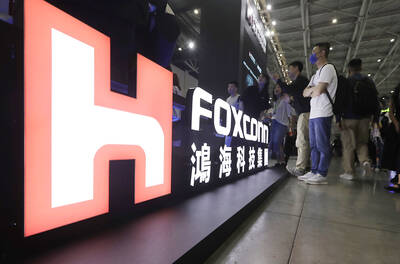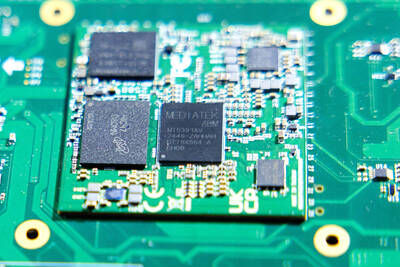US President Donald Trump’s administration has lifted recent export license requirements for chip design software sales in China, as Washington and Beijing implement a trade deal for both countries to ease some restrictions on critical technologies.
The US Department of Commerce informed the world’s three leading semiconductor design software providers — Synopsys Inc, Cadence Design Systems Inc and Germany’s Siemens AG — that requirements to seek government licenses for business in China are no longer in place, according to company statements.
Siemens has restored full access to its software and technology for Chinese customers, the company said, while Synopsys and Cadence said that they are in the process of resuming such services in the Asian country.

Photo: Reuters
White House officials cracked down on sales of electronic design automation (EDA) tools to China in May as part of a raft of measures responding to Beijing’s limits on shipments of essential rare earth minerals. Under a trade agreement finalized last week, Washington promised to allow shipments of EDA software, as well as ethane and jet engines, to China — provided that Beijing first honors its pledge to accelerate export approvals for critical minerals used in everything from wind turbines to airplanes.
The move to lift EDA curbs is a sign that the accord reached in London — which would bring the countries back to the terms of a deal struck the previous month in Geneva, Switzerland — is indeed being implemented.
In addition to chip software sales, the US last week allowed makers of a critical petroleum product to transport gas tankers to Chinese ports and then fully removed those license requirements this week, ethane companies said on Wednesday.
Beijing also achieved a higher-level longtime goal: Washington has now put export controls, a national security tool historically treated as non-negotiable, on the table in trade talks.
The US for years used export controls to limit China’s access to advanced chips and the equipment needed to make them, in an effort to prevent Beijing from developing advanced artificial intelligence that could benefit its military.
Expanding that campaign to encompass EDA software — used to design everything from high-end Nvidia Corp and Apple Inc processors to simple parts like power-regulation components — was a longtime priority for some China hawks in Washington.
The Trump administration had just shown it would intensify China chip curbs by tightening restrictions on Nvidia’s sales.
The EDA measures were unusual because US officials offered little detail on what was and was not allowed — parameters that typically are discussed at length during a formal regulatory process.
Then, barely two weeks after their imposition, US National Economic Council Director Kevin Hassett, speaking at the start of London trade talks, said that the US might ease semiconductor controls he described as “very important” to China.
While Hassett and other senior Trump officials said curbs on Nvidia chips were not up for discussion, the industry lacked clarity throughout the London meetings — and for weeks thereafter — about when, and whether, the EDA curbs would be lifted.
Ultimately, some Washington officials were relieved to see the US offer what they saw as lower-priority semiconductor concessions to Beijing, Bloomberg has reported — safeguarding, at least for now, the Nvidia chip export limits they view as vital.
However, some also see controls on EDA as a crucial step in their own right, one that should not be negotiated away as part of a trade deal.
“EDA software sales had been one of the few remaining inputs to Huawei’s chip development left untouched,” said Ryan Fedasiuk, a former US Department of State China adviser, in reference to the telecom giant Huawei Technologies Co (華為) at the center of Beijing’s semiconductor ambitions. “Restricting EDA licenses would have dealt a decisive blow to the company’s next-gen chip design timelines and hobbled its competitiveness in global markets.”
Meanwhile, EDA companies are contending with a new worry, Bloomberg has reported.
Even with access to the Chinese market restored, customers there might hunt for other suppliers or further develop domestic capabilities in response to heightened geopolitical risks.

Leading Taiwanese bicycle brands Giant Manufacturing Co (巨大機械) and Merida Industry Co (美利達工業) on Sunday said that they have adopted measures to mitigate the impact of the tariff policies of US President Donald Trump’s administration. The US announced at the beginning of this month that it would impose a 20 percent tariff on imported goods made in Taiwan, effective on Thursday last week. The tariff would be added to other pre-existing most-favored-nation duties and industry-specific trade remedy levy, which would bring the overall tariff on Taiwan-made bicycles to between 25.5 percent and 31 percent. However, Giant did not seem too perturbed by the

Foxconn Technology Co (鴻準精密), a metal casing supplier owned by Hon Hai Precision Industry Co (鴻海精密), yesterday announced plans to invest US$1 billion in the US over the next decade as part of its business transformation strategy. The Apple Inc supplier said in a statement that its board approved the investment on Thursday, as part of a transformation strategy focused on precision mold development, smart manufacturing, robotics and advanced automation. The strategy would have a strong emphasis on artificial intelligence (AI), the company added. The company said it aims to build a flexible, intelligent production ecosystem to boost competitiveness and sustainability. Foxconn

TARIFF CONCERNS: Semiconductor suppliers are tempering expectations for the traditionally strong third quarter, citing US tariff uncertainty and a stronger NT dollar Several Taiwanese semiconductor suppliers are taking a cautious view of the third quarter — typically a peak season for the industry — citing uncertainty over US tariffs and the stronger New Taiwan dollar. Smartphone chip designer MediaTek Inc (聯發科技) said that customers accelerated orders in the first half of the year to avoid potential tariffs threatened by US President Donald Trump’s administration. As a result, it anticipates weaker-than-usual peak-season demand in the third quarter. The US tariff plan, announced on April 2, initially proposed a 32 percent duty on Taiwanese goods. Its implementation was postponed by 90 days to July 9, then

AI SERVER DEMAND: ‘Overall industry demand continues to outpace supply and we are expanding capacity to meet it,’ the company’s chief executive officer said Hon Hai Precision Industry Co (鴻海精密) yesterday reported that net profit last quarter rose 27 percent from the same quarter last year on the back of demand for cloud services and high-performance computing products. Net profit surged to NT$44.36 billion (US$1.48 billion) from NT$35.04 billion a year earlier. On a quarterly basis, net profit grew 5 percent from NT$42.1 billion. Earnings per share expanded to NT$3.19 from NT$2.53 a year earlier and NT$3.03 in the first quarter. However, a sharp appreciation of the New Taiwan dollar since early May has weighed on the company’s performance, Hon Hai chief financial officer David Huang (黃德才)